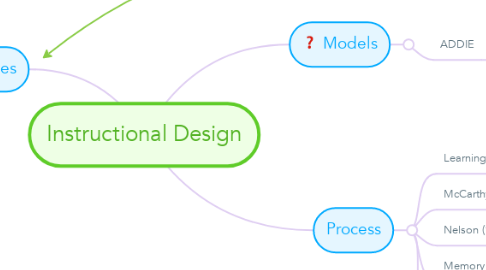
1. Theories
1.1. Learning theories
1.1.1. Behaviorism
1.1.1.1. learning occurs with changes in form/frequency of observable performance
1.1.1.2. Arrangement of stimuli & consequences within the environment mainly influence learning
1.1.1.3. Memory is not addressed
1.1.1.4. Transfer is a result of generalization
1.1.1.5. Building & strengthening stimulus-response associations are effective to facilitate learning
1.1.2. Cognitivism
1.1.2.1. Learning occurs with discrete changes between states of knowledge
1.1.2.2. Learning is concerned with what learners know and how they come to acquire knowledge (Jonassen,1991b)
1.1.2.3. Learners' thoughts,beliefs, attitudes, and values are influential in the learning process
1.1.2.4. Memory is given a prominent role in the learning process
1.1.2.5. Transfer is a function of how information is stored in memory (Schunk 1991)
1.1.2.6. suitable for complex forms of learning (e.g. reasoning, problem solving, information-processing)
1.1.2.7. Emphasize on helping learners organize & relate new information to existing knowledge in memory
1.1.3. Constructivism
1.1.3.1. Learning is creating meaning from experience
1.1.3.2. Specific interaction between learner & environment creates knowledge
1.1.3.3. Memory is under construction as a cumulative history of interactions
1.1.3.4. provide learners with the conceptual power needed to deal with complex & ill-structured problems
1.2. Instructional theories
1.2.1. Robert Gagne's Nine Events of Instruction
1.2.1.1. 1. Gain attention of the students
1.2.1.1.1. Use stories, uncertainty & surprise as stimuli
1.2.1.1.2. Ask thought-provoking questions
1.2.1.1.3. promote peer interactions
1.2.1.2. 2. State learning objectives
1.2.1.2.1. State expected performance
1.2.1.2.2. State criteria for standard performance
1.2.1.2.3. Students involve in setting criteria for standard performance
1.2.1.3. 3. Recall of prior learning
1.2.1.3.1. Ask questions about previous knowledge/experience
1.2.1.3.2. Test students' understanding of previous concepts
1.2.1.4. 4. Present the content
1.2.1.4.1. Present main points
1.2.1.4.2. Provide examples
1.2.1.4.3. Present the same content with diversification (Videos, demonstration, lecture, podcast & group work )
1.2.1.5. 5. Provide learning guidance
1.2.1.5.1. Provide instructional support as needed
1.2.1.5.2. Model varied learning strategies
1.2.1.5.3. Use example & non-examples
1.2.1.5.4. Provide case studies, analogies, visual images & metaphors
1.2.1.6. 6. Elicit performance (practice)
1.2.1.6.1. Elicit student activities
1.2.1.6.2. Elicit recall strategies
1.2.1.6.3. Facilitate student elaborations
1.2.1.6.4. Help students integrate new knowledge
1.2.1.7. 7. Provide feedback
1.2.1.7.1. Positive feedback
1.2.1.7.2. Corrective
1.2.1.7.3. Remedial feedback
1.2.1.7.4. Informative feedback
1.2.1.7.5. Analytical feedback
1.2.1.8. 8. Assessment
1.2.1.8.1. pretest & post-test
1.2.1.8.2. oral questions & quizzes
1.2.1.8.3. objective or criterion-referenced performance for measuring which level the students reach
1.2.1.9. 9. Enhance retention
1.2.1.9.1. Paraphrase content
1.2.1.9.2. Use metaphors
1.2.1.9.3. Generating examples
1.2.1.9.4. Create concept maps or outlines
1.2.1.9.5. Create job-aids, references, templates or wizards
1.2.2. First Principles of Instruction
1.2.2.1. 5 Factors that promote learing
1.2.2.1.1. a. learners are engaged in solving problems
1.2.2.1.2. b. existing knowledge is activated as a foundation for new knowledge
1.2.2.1.3. c. new knowledge is demonstrated to leaners
1.2.2.1.4. d. knowledge is applied by the learner
1.2.2.1.5. e. new knowledge is integrated into learners' world
2. Models
2.1. ADDIE
2.1.1. Analysis
2.1.1.1. Needs
2.1.1.2. Learner
2.1.1.3. Task
2.1.2. Design
2.1.3. Development
2.1.4. Implementation
2.1.4.1. Pilot --> Train the trainer --> Roll out
2.1.5. Evaluation
2.1.5.1. Kirkpatrick's 4-level evaluation
3. Process
3.1. Learning cycle of Star Legacy (Schwartz et al., 1999)
3.1.1. The Challenges-->General Ideas-->Multiple Perspectives-->Research & Revise-->Test Your Mettle-->Go Public-->The Challenges-->...
3.2. McCarthy 4-MAT Cycle of Learning (McCarthy, 1996)
3.2.1. 1. Meaing
3.2.2. 2. Conceptualizing
3.2.3. 3. Operationalizing
3.2.4. 4. Renewing
3.3. Nelson (1999) ----Collaborative Problem Solving
3.3.1. 1. Build readiness
3.3.2. 2. Form & norm groups
3.3.3. 3. Define a preliminary problem
3.3.4. 4. Define & assign roles
3.3.5. 5. Collaborative problem-solving process
3.3.6. 6. Finalize the solution
3.3.7. 7. Synthesize & reflect
3.3.8. 8. Assess products & processes
3.3.9. 9. Provide closure
3.4. Memory
3.4.1. Input-->Sensory memory--(Attention)-->Short-term memory <--(Encoding/Retrieval)-->Long-term memory
3.5. Reinforcement
3.5.1. Stimulus--->Learner(with +/- reinforcements)--->Expected Behaviors
